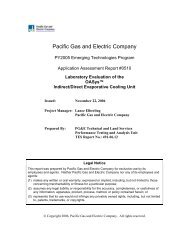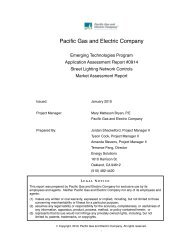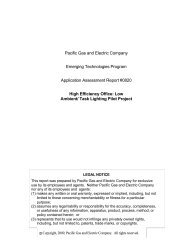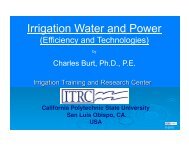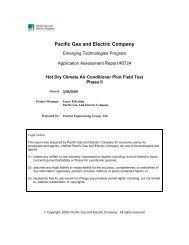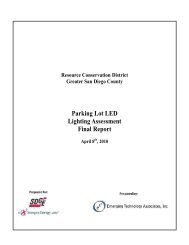Pacific Gas and Electric Company - Emerging Technologies ...
Pacific Gas and Electric Company - Emerging Technologies ...
Pacific Gas and Electric Company - Emerging Technologies ...
You also want an ePaper? Increase the reach of your titles
YUMPU automatically turns print PDFs into web optimized ePapers that Google loves.
Project Background<br />
Evaporative cooling is a powerful natural cooling process that achieves its greatest potential<br />
during hot (<strong>and</strong> dry) summer hours when the outdoor wet bulb depression 2 is greatest.<br />
Evaporative cooling can be used to either directly condition outdoor air for delivery to<br />
conditioned space, or indirectly cool the air, where the moisture addition doesn’t negatively<br />
impact indoor comfort. Since indirect cooling processes do not affect indoor humidity levels,<br />
technologies that incorporate indirect cooling will likely have increased market acceptance. One<br />
such technology is residential-scale evaporative condensers. These systems utilize cooling tower<br />
technology to replace the typical air cooled condenser 3 with a system that generates refrigerant<br />
condensing temperatures lower than the outdoor dry bulb temperature. Reduced refrigerant<br />
condensing temperatures translate to higher cooling capacity <strong>and</strong> reduced compressor dem<strong>and</strong>,<br />
resulting in higher operating efficiencies. Equally as significant as the improved performance is<br />
the resulting stable cooling capacity with outdoor temperature. Unlike air-cooled systems that<br />
lose cooling capacity at a rate of roughly 5% per ten degrees of outdoor temperature rise,<br />
evaporative condensers demonstrate much more stable performance. Since heat storm weather<br />
spells in California <strong>and</strong> other dry Southwestern climates are characterized by very low outdoor<br />
humidities, the relative benefit of evaporative condensers actually increases during heat storm<br />
events when the electrical grid is most heavily taxed.<br />
The only residential evaporative condenser currently positioned in the marketplace is the Freus<br />
unit which first appeared in 2000. Freus is headquartered in Anthony, Texas <strong>and</strong> has produced<br />
approximately 6,500 by mid-2006 (Esource, 2006) with plans for sales of several thous<strong>and</strong> units<br />
in 2007. Mainstream HVAC manufacturers are well aware of the technology, but have shied<br />
away from it largely due to two reasons: First, a concern over long term reliability of HVAC<br />
equipment that introduces water <strong>and</strong> the associated scale deposits from evaporation, <strong>and</strong> second,<br />
a perception that the technology represents a product suited for regional, not national markets.<br />
The technology should expect increased attention in the years ahead based on the expected<br />
energy <strong>and</strong> peak dem<strong>and</strong> savings of 30-40% touted by proponents.<br />
Figure 1 provides a schematic of the Freus evaporative condenser. A water sump at the base of<br />
the unit collects water that is circulated from the sump to the water spray system. The condenser<br />
fan pulls air through the base of the unit past the sprayed condenser coil. The impact of<br />
improved condenser to water heat transfer <strong>and</strong> the powerful evaporative cooling effect<br />
contributes to the enhanced heat transfer <strong>and</strong> improved efficiencies. A product brochure can be<br />
found in Appendix A.<br />
2 The difference between dry bulb <strong>and</strong> wet bulb temperatures<br />
3 Typical residential air-cooled condensing units operate at refrigerant condensing temperatures 20-25°F higher than<br />
the outdoor dry bulb temperature.<br />
© Copyright, 2008, <strong>Pacific</strong> <strong>Gas</strong> <strong>and</strong> <strong>Electric</strong> <strong>Company</strong>. All rights reserved.<br />
Page 4



